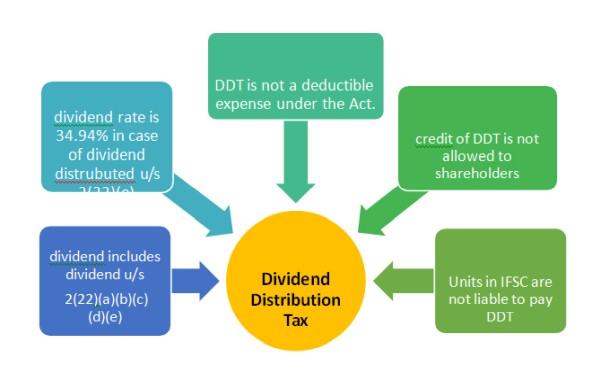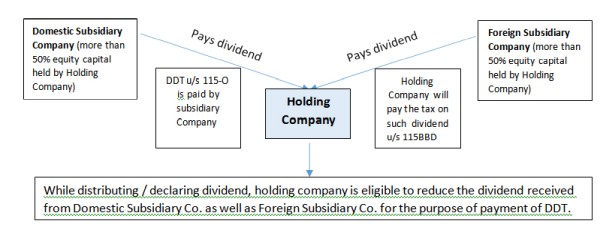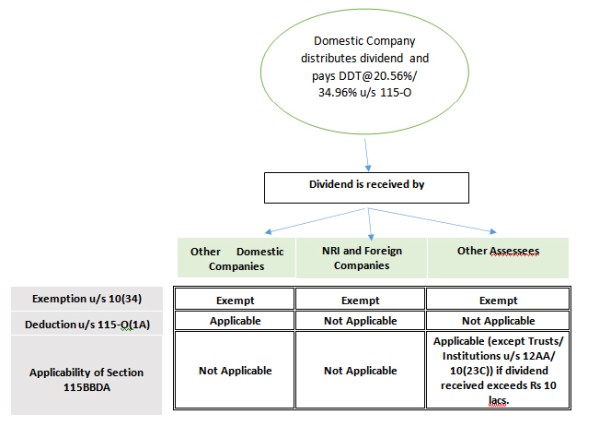Introduction
The budget 2020 was introduced in the backdrop of economic slowdown. The estimated growth rate plunged to 5% for the FY 2020-21 from a standard 6.8% recorded for the FY 2019-20. However, despite the global economic recession knocking the entrance door, Indian economy still has higher expectations.
Honourable Finance Minister Smt. Nirmala Sitaraman started off her budget speech by delivering that we wish to open India for a vibrant and dynamic economy. Finance bill aims increasing purchasing power of people by boosting investments, pulling down unemployment rates and attracting foreign capital. One of the significant decisions taken towards this objective is Abolition of Dividend Distribution Tax.

Points of Discussion:
1) What is Dividend?
Section 2(35) of the Companies Act, 2013 says 'Dividend includes interim dividend'. As per generally accepted definition, dividend includes the portion of company's profit distributed to shareholders in proportion of their paid up capital.
2) What is Dividend Distribution Tax?
Every domestic Company in India which distributes dividend to its shareholders must pay tax on the dividend. This tax is called dividend distribution tax (DDT). Tax is to be paid @ 15% and effective tax rate amounts to 20.56 % (after including cess and surcharge and grossing up). Provisions of DDT are governed under section 115-O of the Act.
3) Provisions pertaining to Dividend Distribution Tax?
a) Section 115-O – Dividend Distribution Tax by Domestic Companies

b) Section 10(34) - Exemption to Shareholders
Dividend received by Shareholders from Domestic Companies is exempt u/s 10(34) of the Act. Since DDT is already paid by Domestic companies on dividend distributed or declared by them, the same dividend received by shareholders cannot be taxed again in their hands and thus, it is exempt in hands of shareholders u/s 10(34) of the Act.`
c) Section 115-O (1A): Reduction in Dividend Distribution Tax

d) Section 115BBDA – Taxability of dividend received exceeding Rs. 10 lakhs in certain cases Shareholders are not liable to pay tax on dividend received from domestic companies by virtue of section 10(34). However, if any shareholder receives total dividend exceeding Rs. 10 lakh from all the domestic companies in which he is a shareholder, then he shall be liable to pay additional tax @10% plus cess u/s 115BBDA of the Act on the amount of dividend which exceeds Rs. 10 lakhs. However, the following assessees being shareholders are excluded from the applicability of Section 115BBDA:-
• Domestic Companies
• Trusts/ Institution registered u/s 12AA/ 10(23C).
• Non Residents and Foreign Companies.
Illustration:
Let us take example to explain the effect of all these provisions:-
Company XYZ Ltd. declares annual dividend amounting to Rs. 80 Crores for the FY 2019-20 on 31st March 2020. Out of Rs. 80 Crores of dividend distributed, Rs. 10 Crores of dividend qualifies for Dividend u/s 2(22)(e). Company has 1000 shareholders. Company receives dividend of Rs. 10 Crores from its subsidiaries. One shareholder A is also shareholder in Company PQR Ltd. and receives dividend of Rs. 6.5 lakhs after DDT from PQR Ltd.
Following is the impact of above situation:-
I) For XYZ Ltd.
|
Rs. |
|
|
Dividend Distributed |
80,00,00,000 |
|
(-): Deduction of dividend received from subsidiaries u/s 115-O(1A) |
(10,00,00,000) |
|
Dividend Liable for DDT |
70,00,00,000 |
|
DDT @ 34.944% on dividend u/s 2(22)(e) [Rs. 10,00,00,000*34.944%] |
3,49,44,000 |
|
DDT @ 20.56% on other dividend [(Rs. 70,00,00,000 - Rs. 10,00,00,000)*20.56%] |
12,33,60,000 |
II) For Shareholders
|
Rs. |
|
|
A) Dividend Received by shareholders post deduction of DDT u/s 2(22)(e) (Rs. 10,00,00,000- Rs. 3,49,44,000) |
6,50,56,000 |
|
B) Dividend received by shareholders post DDT other than u/s 2(22)(e) (Rs. 70,00,00,000- Rs. 12,33,60,000) |
57,66,40,000 |
|
C) No. of Shareholders |
1,000 |
|
D) Dividend received per shareholder (Rs. 57,66,40,000 + Rs. 6,50,56,000)/1000 |
6,41,696 |
|
E) Tax payable by shareholders on dividend received |
Nil Exempt u/s 10(34) |
III) For Shareholder A
|
Dividend received from Company XYZ Ltd. |
Rs. |
|
a) u/s 2(22)(e) (Rs. 6,50,56,000/1000) |
65,056 |
|
b) other dividend received (Rs. 57,66,40,000/1000) |
5,76,640 |
|
Dividend received from Company PQR Ltd. |
6,50,000 |
|
Total dividend received [except 2(22)(e)] (Rs. 6,50,000 + Rs. 5,76,640) |
12,26,640 |
|
Tax u/s 115BBDA (Note) (Rs. 12,26,640 – Rs. 10,00,000)*10.4% |
23,571 |
Note: 115BBDA is not applicable on dividend received u/s 2(22)(e). Also, tax under this section is paid on amount in excess of Rs. 10,00,000
DDT in a Nutshell

4) Amendment in Finance Bill, 2020
Finance Bill 2020 proposes to abolish dividend distribution tax shift the burden of tax on dividend over the shareholders.
5) Purpose of Amendment:
Memorandum to Finance Bill proposes for moving towards classical system of taxing dividend in the hands of shareholders/unit holders. The dividend is income in the hands of shareholders and not company. Therefore, the incidence of tax should fall on the shareholders.
6) Impact of Amendment of other sections of the Act:
• Section 115O, 115R, 115BBDA, 10(34), 10(35) will remain operative till 31 March 2020.
• Section 57 of Act has been amended for capping the deduction of interest paid in earning dividend income to the extent of 20% such income
• Amendment in section 194 to include dividend for tax deduction.
• Amendment in section 194LBA to provide for tax deduction by business trust on dividend income paid to unit holder, at the rate of ten per cent for resident. For non-resident, it would be 5 % for interest and 10% for dividend.
7) Implications of Amendment
Implication on Domestic Companies
• No Obligation to pay DDT
Companies have been relieved from the obligation of paying DDT on dividend declared, distributed or paid. This is a welcoming initiative in Finance Bill 2020.
• Additional Liability to deduct TDS
Companies will now be required to deduct TDS on dividend declared, distributed or paid to the shareholders. TDS will be deducted u/s 194 of the Act. This amendment is necessary for keeping track of dividend received by shareholders.
• Introduction of Section 80 M
Section 80M of the Act has been reintroduced in Finance Bill 2020, for the sake of avoiding cascading effect on dividend.
As per section 80M, if domestic company received dividend from another domestic company, then the company receiving dividend can claim deduction of such dividend from its Gross Total Income u/s 80M. However, dividend could be availed if:-
a) Dividend is declared by recipient domestic company to its shareholders at last before 1 month of due date of return filing
b) Amount of dividend is limited to dividend received or dividend declared by it, whichever is lower.
Implications on Shareholders
• Abolition of DDT disadvantageous to High Income Tax payers-
Tax Payers receiving dividend and falling under lower tax rate structure would benefit from abolition of DDT. However, Promoters/Taxpayers falling under higher income group would have to pay taxes on dividend, which ranges from 34% to 43%, depending on their slab rates.
Following is a brief illustration for further clarification:
Question: Suppose Company A earns annual profits of Rs. 100. Following is the analysis of dividend distributed pre and post abolition of DDT.
|
Prior to abolition of DDT |
Post abolition of DDT |
|
|
Earnings before Tax |
100.00 |
100.00 |
|
Less: Corporate Tax @ 29.12% [25% +4% + 12% (surcharge)] |
(29.12) |
(29.12) |
|
Profit available for distribution |
70.88 |
70.88 |
|
Less: DDT @ 20.56% |
(14.57) |
N.A. |
|
Dividend distributed to shareholders |
56.31 |
70.88 |
|
Prior to abolition of DDT |
Post abolition of DDT |
|
|
Dividend Received By shareholders |
56.31 |
70.88 |
|
Case I: Shareholder falls in the slab 0-5 lacs Tax Rate= Nil (after rebate u/s 87A) |
- |
- |
|
Net Dividend Received |
56.31 |
70.88 |
|
Case II: Shareholder falls in the slab 5-10 lacs Tax Rate= 20%+4%cess=20.8% |
- |
(14.74) |
|
Net Dividend received |
56.31 |
56.14 |
|
Case III: |
(5.86) |
|
|
Shareholder falls in the slab 10-50 lacs Tax Rate= 30%+4%cess=31.2% |
[10.4% of 56.31, considering Section |
(22.11) |
|
115BBDA is applicable] |
||
|
Net Dividend Received |
50.45 |
48.77 |
|
Case IV: |
(5.86) |
|
|
Shareholder falls in the slab 50 lacs – 1 Cr Tax Rate= 30%+10% (surcharge) +4% |
[10.4% of 56.31, considering Section |
(24.33) |
|
(cess)= 34.32% |
115BBDA is applicable] |
|
|
Net Dividend Received |
50.45 |
46.55 |
|
Case V: |
(5.86) |
|
|
Shareholder falls in the slab 1-2Cr Tax Rate= 30%+15% (surcharge) +4% |
[10.4% of 56.31, considering Section |
(25.43) |
|
(cess) = 35.88% |
115BBDA is applicable] |
|
|
Net Dividend Received |
50.45 |
45.45 |
|
Case VI: Shareholder falls in the slab 2-5Cr Tax Rate= 30%+25% (surcharge) +4% (cess) = 39% |
(5.86) [10.4% of 56.31, considering Section 115BBDA is applicable] |
(27.64) |
|
Net Dividend Received |
50.45 |
43.24 |
|
Case VII: Shareholder falls in the slab 5 Cr above Tax Rate= 30%+37% (surcharge) +4% (cess) = 42.74% |
(5.86) [10.4% of 56.31, considering Section 115BBDA is applicable] |
(30.3) |
|
Net Dividend Received |
50.45 |
40.58 |
The above table shows that only shareholders falling in the slabs 0-2.5, 2.5-5 or 5-10 lacs have higher dividend available in hand than before. Rest of the shareholders having taxable income above Rs. 10 lacs will have lesser dividend in hand than before.
One Category of Shareholders having hit by the new system of dividend is the promoter group. Being placed in the upper tax bracket, they would now have to pay tax on dividend at a rate as high as 43%. Thus, promoters would aim at distribution of dividend before 31st of March 2020. That is the reason we have seen the companies having high promoter holding coming up with flurry of dividend announcements before 31st of March 2020.
One alternative of avoiding high tax obligation in the hands of shareholders on account of dividend distribution could be buyback of shares. As per section 115QQA of the Act, companies going for buyback of shares would have to pay tax @ 23.3% [20% + 12% (surcharge) + 4% (cess)] on buyback consideration. Though this route is beneficial for promoters in terms of tax savings, however it results in dilution of promoters' shareholding in the Company.
• Reduced tax cost of Foreign Investment:
Scenario Prior to Amendment:
In the existing dividend taxation system, dividend received by NRI Investors and foreign companies from domestic companies is exempt from tax u/s 10(34) in India. However, such dividend income becomes taxable in their home country. Moreover, these foreign investors do not get any tax credit of DDT paid on their dividend by the domestic companies. Thus, foreign investors end up paying taxes on dividend income in their home country, without getting any tax credit of DDT paid in India.
Scenario Post Amendment:
With the advent of new system, exemption u/s 10(34) is withdrawn and dividend income is now taxable in India in the hands of foreign investors @20% (plus tax plus surcharge) as per amended section 115A of the Act. But unlike before, non-resident shareholders can avail credit of tax paid in India in their home country. Moreover, Tax rate on dividend defined in Article 10 of Double Taxation Avoidance Agreement ranges between 5%-15% with most of the countries.
|
S. No. |
Country |
Rate |
|
1 |
UK |
10% |
|
2 |
USA |
15% |
|
3 |
Singapore |
10% |
|
4 |
Netherlands |
10% |
|
5 |
Luxembourg |
10% |
|
6 |
China |
10% |
Furthermore, the assessee has the option to be governed by Income Tax Law or DTAA, whichever is more beneficial to him [Section 90(2)]. Thus the non-resident shareholder can opt to pay tax at lower rates as prescribed in DTAA by invoking Section 90(2). It could be explained from the following table:-
|
Prior to abolition of DDT |
Post abolition of DDT |
|
|
A) Dividend declared by Domestic Company |
100 |
100 |
|
B) DDT @20.56% |
(20.56) |
- |
|
C) Dividend received by Non-resident Shareholder [A-B] |
79.44 |
100 |
|
D) Tax Rate in India |
Nil [Exempt u/s 10(34)] |
10 % (average) (considering DTAA option availed) |
|
E) Net dividend received in India [C-D] |
79.44 |
90 |
|
F) Tax Rate in Home Country |
40% |
40% |
|
G) Total Tax paid in home country [E*F] |
31.78 |
36 |
|
H) Credit of Taxes paid in India |
NA |
10 |
|
I) Net Tax Cost [G-H] |
31.78 |
26 |
|
J) Net Dividend in Hand [E-I] |
47.66 |
64 |
The above table shows that abolition of DDT results in reduced tax cost of non-resident shareholders' investments in India and this will ultimately yield them higher returns on their investments.
Introduction of this system of dividend taxation will definitely attract foreign capital and boost investments, which was one of the prime objectives of this Finance Bill. Thus, it is a win – win situation for both the foreign investors and government.
8) Conclusion
Finance Bill 2020 was introduced amidst the global economic recession. Creation of jobs through boosting investments is the need of the hour to revamp the plunging economy. Abolition of dividend is one of the major initiatives given to domestic companies to adopt an investment oriented approach. Following are the takeaways from this amendment:
• Domestic Companies are relieved from deduction of DDT on dividend distributed. However, now they will have to deduct TDS for dividend distributed to each of its shareholder.
• Abolition of DDT is disadvantageous to Promoters and Shareholders belonging to higher tax brackets.
• Tax borne by non-resident shareholders will reduce significantly, which implies higher inflow of foreign capital into the country.







 CAclubindia
CAclubindia
